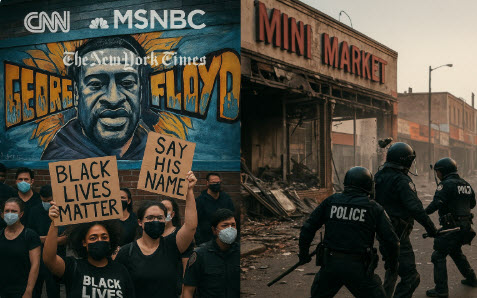On May 25, 2020, an arrest in Minneapolis became a flashpoint that changed the trajectory of the United States. George Floyd, a 46-year-old African American man, died under the knee of police officer Derek Chauvin as bystanders recorded and pled for mercy. The images were horrifying, the cries—“I can’t breathe”—heartbreaking. Within hours, a flood of media coverage, protest, and outrage surged across the country, catalyzing not just grief but cultural upheaval. But as the weeks unfolded, the incident revealed far more than the tragic death of a man. It exposed fault lines—ideological, political, moral—and raised critical questions about justice, race, law enforcement, and truth itself.
The Timeline Behind the Tragedy
The incident began with a 911 call reporting Floyd’s attempt to pass a counterfeit $20 bill. Police arrived, and bodycam footage later revealed that Floyd resisted getting into the police car, repeatedly saying he was claustrophobic. Officers attempted to subdue him, leading to the now-infamous scene where Chauvin pinned Floyd to the ground with a knee on his neck.
That footage, shot by a bystander, was uploaded to social media that evening—and the firestorm erupted. Within 24 hours, peaceful protests formed in Minneapolis. By the second day, violence had escalated. Cities across America descended into chaos. The Minneapolis 3rd Precinct was torched. Businesses burned. Federal buildings were attacked. What began as a call for justice morphed into a full-fledged national upheaval.
How the Media Shaped the Moment
The news media played an outsized role in shaping how the public understood this event.
Progressive outlets like CNN, The New York Times, and MSNBC framed the story immediately as a symbol of systemic racism—an execution, they suggested, carried out by a white officer against a helpless Black man. The framing was emotionally powerful and unequivocal. There was little room for nuance or alternative interpretation.
Terms like “lynching,” “modern-day Jim Crow,” and “state-sanctioned murder” became common parlance. In contrast, the widespread riots, looting, and destruction were downplayed or euphemized as “mostly peaceful protests,” despite the billions in damage and hundreds of police injuries.
Conservative outlets such as Fox News, The Federalist, and The Daily Wire did not excuse Chauvin’s actions, but insisted that Americans needed all the facts—including Floyd’s toxicology report, his criminal history, and the bodycam footage that showed him resisting arrest. These were not offered to minimize Floyd’s death, but to counter a media narrative that had solidified into dogma before the trial ever began.
The difference in coverage illustrated more than political bias—it revealed two competing visions of America. In one, America is a racist nation requiring revolutionary change. In the other, America is a good nation that sometimes fails, but must seek truth over hysteria and maintain order as the foundation of justice.
Political Opportunism and Ideological Hijacking
No tragedy in recent memory was so swiftly politicized.
Democratic leaders seized the moment. Nancy Pelosi, Joe Biden, and Kamala Harris echoed the language of systemic oppression. Activist groups like Black Lives Matter were elevated to moral authority, despite their founders’ open embrace of Marxism and anti-family values.
The Floyd incident became the emotional engine behind calls to “Defund the Police,” overhaul public education with critical race theory (CRT), and purge government and private institutions of so-called “implicit bias.” Cities rushed to reallocate police budgets and expand DEI (Diversity, Equity, and Inclusion) programs. Many of these measures were championed not because they were effective, but because they aligned with the ideological narrative.
Meanwhile, Republicans called for justice but stood against the tide of revolutionary change. President Trump condemned Chauvin but also condemned the destruction that followed. He proposed modest police reforms, which were summarily dismissed by Democrat leaders. Conservatives warned that using one man’s death to delegitimize all police was reckless and unjust.
The Truth the Media Buried
Much of the American public never heard about the facts that contradicted the official story.
Autopsy reports showed that Floyd had potentially lethal levels of fentanyl and methamphetamines in his system. The medical examiner acknowledged that while Chauvin’s knee contributed to the death, the drugs and pre-existing conditions were also significant. This didn’t excuse the force used—but it did complicate the simplistic “murder” narrative.
Later, bodycam footage surfaced showing Floyd saying “I can’t breathe” even before being restrained on the ground. This video had been withheld for months. Why? Because it would have undermined the carefully constructed media story. Likewise, the media refused to give comparable coverage to similar or worse incidents involving white victims of police abuse—like Tony Timpa—because such stories didn’t support the systemic racism narrative.
This selective amplification is not just bias. It is narrative control.
Cultural Aftershocks: What Changed?
America changed drastically in the months following Floyd’s death.
- Over $2 billion in damage was done during the riots. Cities were burned. Small businesses—many minority-owned—were destroyed.
- Law enforcement morale collapsed. Officers resigned or retired in droves. Recruitment numbers fell. Crime soared.
- Corporate America capitulated. Fortune 500 companies released BLM statements, funded radical groups, and imposed CRT-inspired trainings.
- Churches buckled. Many Evangelical leaders issued “racial repentance” statements and urged their congregations to support social justice movements—often without theological clarity.
Even American history came under attack. Statues of not only Confederate generals but also of George Washington and Abraham Lincoln were defaced or removed. The narrative had moved beyond justice for Floyd—it had become a cultural revolution.
A Neo-Marxist Strategy Unfolds
Observers from thinkers like Thomas Sowell to pastors like Voddie Baucham recognized the deeper ideological forces at work. This wasn’t merely grief over injustice—it was the opportunistic exploitation of tragedy by Neo-Marxist activists.
Trained organizers used Floyd’s death to push for the overthrow of traditional values, capitalism, the nuclear family, and even objective truth. BLM’s website (since scrubbed) explicitly listed the disruption of the Western-prescribed family as a goal. The protests became liturgies of ideological possession: chanting names, kneeling in public, raising fists. Secular wokeism had become a new religion—with George Floyd as its martyr.
A Christian Response: Grief and Discernment
As Christians, we grieve the loss of life. George Floyd bore the image of God, as does every man. Justice matters to God. But biblical justice is not mob vengeance or social engineering. It is impartial, truth-based, and rooted in the law of God (Leviticus 19:15).
We must beware false balances—of giving preference to narratives rather than evidence. Proverbs 18:17 warns, “The one who states his case first seems right, until the other comes and examines him.” This entire saga is a textbook case of that warning.
The Church must also be cautious not to adopt ideologies that conflict with Scripture. CRT, intersectionality, and Neo-Marxism do not seek to reform—they seek to replace the gospel with a counterfeit justice rooted in envy, group identity, and endless accusation.
Conclusion: Beyond the Headlines
The death of George Floyd was tragic. The pain felt by many Americans was real. But the aftermath—the riots, the lies, the manipulation, the erasure of truth—did more to divide America than to heal it. What began as a plea for justice became an opportunity for ideological conquest.
This incident must not be remembered only for what was done to George Floyd, but also for what was done in his name. Institutions were captured. Children were indoctrinated. Truth was buried beneath slogans.
As believers, we are not called to follow the world’s passions. We are called to stand for truth, love our neighbor, and pursue justice that reflects the character of a holy God. That will require courage, clarity, and compassion in a world increasingly shaped by deception.
S.D.G.,
Robert Sparkman
rob@christiannewsjunkie.com
RELATED CONTENT
Concerning the Related Content section, I encourage everyone to evaluate the content carefully.
Some sources of information may reflect a libertarian and/or atheistic perspective. I may not agree with all of their opinions, but they offer some worthwhile comments on the topic under discussion.
Additionally, language used in the videos may be coarse. Coarse language does not reflect my personal standards.
Finally, those on the left often criticize my sources of information, which are primarily conservative and/or Christian. Truth is truth, regardless of how we feel about it. Leftists are largely led by their emotion rather than facts. It is no small wonder that they would criticize the sources that I provide. And, ultimately, my wordview is governed by Scripture. Many of my critics are not biblical Christians.
Feel free to offer your comments below. Respectful comments without expletives and personal attacks will be posted and I will respond to them.
Comments are closed after sixty days due to spamming issues from internet bots. You can always send me an email at rob@christiannewsjunkie.com if you want to comment on something, though.
I will continue to add items to the Related Content section as opportunities present themselves.

